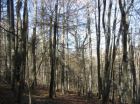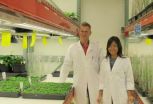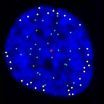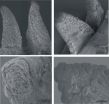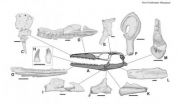(Press-News.org) URBANA – Due to the introduction of exotic pests and pathogens, tree species are being eliminated one by one from forest ecosystems. In some cases, scientists can observe immediately how their loss affects the environment, whereas in other cases, creative puzzle solving and analysis reveal unexpected repercussions. In the case of the loss of the hemlock tree, University of Illinois landscape and ecosystem ecologist Jennifer Fraterrigo uncovered a surprising benefit to hardwood species.
Throughout much of the eastern United States, a pest called the hemlock woolly adelgid has decimated hemlock tree populations. While researching how hemlock mortality affects nitrogen retention in the soil and vegetation, Fraterrigo noticed that other components of the ecosystem were changing.
"Our findings were unexpected," Fraterrigo said. "We hypothesized that in this area of the southern Appalachians, where there is a lot of nitrogen available due to high rates of atmospheric nitrogen deposition, hemlock mortality would increase nitrogen leaching from the soil because the trees were no longer taking up that nitrogen, but we found the opposite. We found less nitrogen leaching from the soil because hardwood trees had compensated by increasing their productivity."
The hardwood trees were able to grow because, when the hemlock trees died, phosphorus was released and became available to the hardwood species in the area. The increase in available phosphorus stimulated the growth of existing hardwood trees, which then increased tree demand for nitrogen. As a result, we saw less nitrogen being leached from the soil. Without hemlock mortality, the hardwood trees could not take up the excess nitrogen in the soil because their growth was limited by a lack of phosphorus, Fraterrigo said.
"We believe chronically high nitrogen availability is actually driving the accumulation of phosphorus in vegetation and soil organic matter in this area. Without disturbance, however, the phosphorus stays locked up in these pools and is unavailable to support new growth," Fraterrigo said.
Fraterrigo explained how the balance of nutrients operates in the environment.
"Nitrogen and phosphorus are among the most important elements for growth and carbon storage," she said. "Plants fix carbon in the atmosphere, but if they don't have enough of either of these elements, they're limited as to how much carbon they can actually fix. It is the relative, not the absolute, amounts of nitrogen and phosphorus that limit growth and carbon storage."
Although this would seem to be beneficial, at least for the hardwood industry, Fraterrigo said it's important to look at the entire ecosystem and the ramifications of losing a species such as hemlock. Fraterrigo said hemlock is significant ecologically. "It's a foundation species in this ecosystem. It provides structure because it's an evergreen so wildlife depends on it year round for shelter. It also influences many biophysical processes, including those that affect ecosystem hydrology. Losing a species such as hemlock that is biologically active all year can alter stream flow, which could affect aquatic organisms," she said.
Fraterrigo said that disturbances created by exotic pathogens and pests such as the hemlock woolly adelgid are increasing. "An introduced fungus is decimating oak populations in the West, and there's the emerald ash borer in the Midwest. We need to study how the loss of tree species is affecting forest ecosystems," she said.
The only places that hemlock stands can still be found in the Southeast are where an insecticide called Imidacloprid has been sprayed, Fraterrigo said. "But that's just a temporary solution. You'd have to continue to apply it again and again in order to deter the hemlock woolly adelgid."
The hemlock woolly adelgid is host specific, meaning it only infests hemlock trees. The aphid-like insect attaches itself to a needle, sucks the sap from it, and the tree dies.
"Although the hemlock woolly adelgid doesn't do well in cooler climates, it is clearly affecting hemlock populations in the Northeast as well. It's just taking longer to see the impact," Fraterrigo said. "We're seeing warmer temperatures at night across the nation and warmer winter temperatures in some places. Those two factors together could allow the insect to move slowly farther north.
"It's difficult to anticipate how species loss will affect forest ecosystems," she said. "Our research demonstrates that it is important to consider other drivers of global change, such as air pollution, to reveal ecosystem-level changes."
Fraterrigo said she'd like to continue the work in the Great Smoky Mountain National Park, which has also lost hemlock and has even higher rates of atmospheric nitrogen deposition. "We're curious if we'll see similar changes in hardwood productivity and ecosystem nitrogen retention," she said.
Interactive effects of disturbance and nitrogen availability on phosphorus dynamics of southern Appalachian forests was published in a 2012 issue of Biogeochemistry.
Impacts of hemlock loss on nitrogen retention vary with soil nitrogen availability in the southern Appalachian Mountains was published in a 2012 issue of Ecosystems.
INFORMATION:
Other authors were Corinne Block, Jennifer Knoepp, and Katherine Elliott.
Partial funding was provided by federal Hatch, the USDA Forest Service, and the National Science Foundation Long-Term Ecological Research Program.
Death of hemlock trees yields new life for hardwood trees, but at what cost to the ecosystem?
2012-12-20
ELSE PRESS RELEASES FROM THIS DATE:
Discovery may pave way to genetically enhanced biofuel crops
2012-12-20
Best known for its ability to transform simmering pots of sugared fruit into marmalades and jams, pectin is a major constituent of plant cell walls and the middle lamella, the sticky layer that glues neighboring plant cells together. Pectin imparts strength and elasticity to the plant and forms a protective barrier against the environment. Several different kinds of pectic compounds combine to form pectin. The relative proportion of each of these depends on the plant species, location within the plant, and environment. Pectic compounds decorated with β-1,4-galactan ...
Chromosome 'anchors' organize DNA during cell division
2012-12-20
LA JOLLA, CA----For humans to grow and to replace and heal damaged tissues, the body's cells must continually reproduce, a process known as "cell division," by which one cell becomes two, two become four, and so on. A key question of biomedical research is how chromosomes, which are duplicated during cell division so that each daughter cell receives an exact copy of a person's genome, are arranged during this process.
Now, scientists at the Salk Institute have discovered a new characteristic of human cell division that may help explain how our DNA is organized in the ...
From farm to table, mealworms may be the next best food
2012-12-20
Food enthusiasts interested in sustainable farm practices may soon have a new meat alternative: insects. Beetle larvae (called mealworms) farms produce more edible protein than traditional farms for chicken, pork, beef or milk, for the same amount of land used, according to research published December 19 in the open-access journal PLOS ONE by Dennis Oonincx and colleagues from the University of Wageningen, Netherlands.
The researchers compared the environmental impact of meat production on a mealworm farm to traditional animal farms using three parameters: Land usage, ...
Human history preserved in tree rings of prehistoric wooden wells
2012-12-20
Prehistoric farming communities in Europe constructed water wells out of oak timbers, revealing that these first farmers were skilled carpenters long before metal was discovered or used for tools. The research published December 19 in the open access journal PLOS ONE by Willy Tegel and colleagues from the University of Freiburg, Germany, contradicts the common belief that metal tools were required to make complex wooden structures.
The wooden water wells discovered in eastern Germany are over 7000 years old, and suggest that these early farmers had unexpectedly refined ...
Lizard tails detach at a biological 'dotted line'
2012-12-20
Like sheets of paper marked with perforated lines, gecko tails have unique structural marks that help them sever their tails to make a quick getaway. Though voluntarily shedding a body part in this manner is a well-known phenomenon, research published December 19 in the open access journal PLOS ONE reveals aspects of the process that may have applications for structural engineers making similar, quickly detachable structures.
VIDEO:
Bridging structures are not present between ...
Music with dinner: Whales sing during foraging season, not just while breeding
2012-12-20
Humpback whales might be expected to take their food seriously given their enormous size, but a new study shows that they may multi-task as they eat, singing mating or breeding songs as they forage in their Antarctic feeding grounds. The research, published December 19 in the open-access journal PLOS ONE by Alison Stimpert from the Naval Postgraduate School and colleagues, sheds new light on the whales' singing habits in different seasons, which are still a mystery.
Whales sing most frequently during the breeding season but are known to sing on other occasions, such as ...
First freshwater mosasaur discovered
2012-12-20
A new mosasaur species discovered in Hungary is the first known example of this group of scaled reptiles to have lived in freshwater river environments similar to modern freshwater dolphins, according to research published December 19 in the open-access journal PLOS ONE by Laszlo Makadi from the Hungarian Natural History Museum, Hungary and colleagues from the University of Alberta, Canada and MTA-ELTE Lendület Dinosaur Research Group, Hungary.
The species lived about 84 million years ago, the largest specimens reached about 20 feet in length, and belongs to a family ...
Transplanted neural stem cells treat ALS in mouse model
2012-12-20
LA JOLLA, Calif., December 19, 2012 – Amyotrophic lateral sclerosis (ALS), also known as Lou Gehrig's disease, is untreatable and fatal. Nerve cells in the spinal cord die, eventually taking away a person's ability to move or even breathe. A consortium of ALS researchers at multiple institutions, including Sanford-Burnham Medical Research Institute, Brigham and Women's Hospital, and the University of Massachusetts Medical School, tested transplanted neural stem cells as a treatment for the disease. In 11 independent studies, they found that transplanting neural stem cells ...
Unraveling the threads: Simplest cotton genome offers clues for fiber improvements
2012-12-20
From the stockings decorating mantles to the new outfits in display windows calling to shoppers, cotton is woven into the fabric of the holiday season. For bioenergy researchers, however, fiber composition matters more than color and texture as each cotton strand is composed of more than two dozen coils of cellulose, a target biomass for next-generation biofuels.
In the December 20, 2012 edition of Nature, an international consortium of researchers from 31 institutions including a team from the U.S. Department of Energy Joint Genome Institute (DOE JGI) present a high-quality ...
Occasional family meals enough to boost kids' fruit and veg intake
2012-12-20
Eating meals together as a family, even if only once or twice a week, increases children's daily fruit and vegetable intake to near the recommended 5 A Day, according to researchers at the University of Leeds.
The study of primary school-aged children, funded by the National Institute for Health Research Public Health Research (NIHR PHR) Programme, also suggests parental consumption of fruit and vegetables and cutting up portions of these foods boosted children's intake. It is published today in the British Medical Journal's Journal of Epidemiology & Community Health.
Overall, ...
